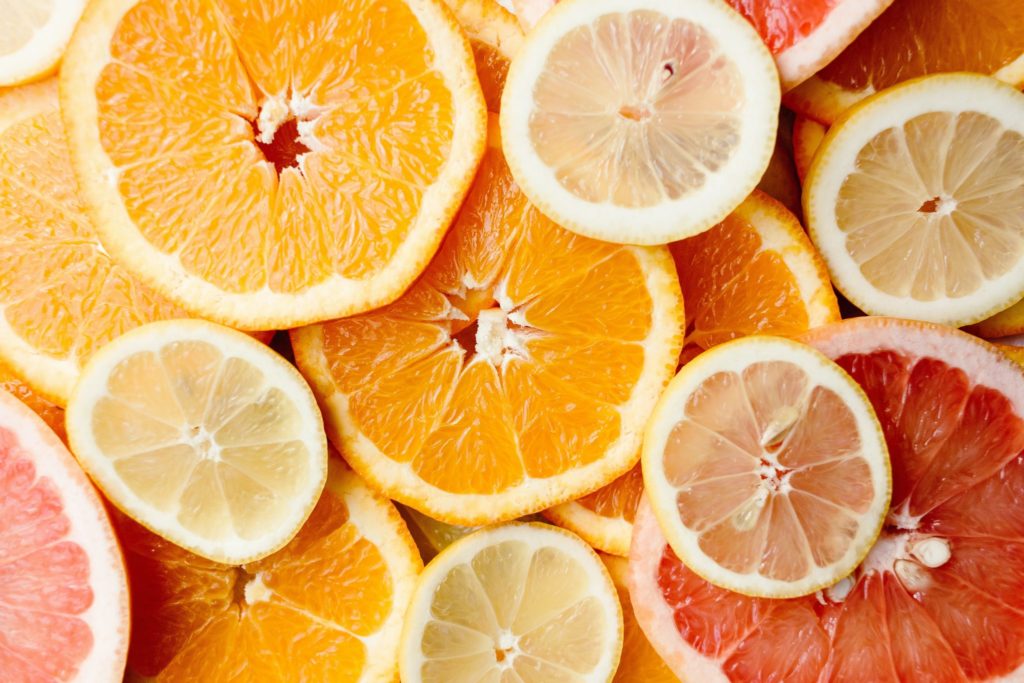Vitamin C is one of the most commonly used supplements…but did you know you can get all the benefits of vitamin C and other nutrients from delicious citrus fruits, like oranges and lemons?
Citrus fruits are in season during winter – nature’s clever way of protecting you from colds and flu. During winter when you’re exposed to cooler weather, colds and flu, citrus fruits – with their high vitamin C and antioxidant content – offer you some protection.
While vitamin C can’t prevent you from catching a virus, it may help you recover faster. A diet containing plenty of vitamin C will support your immune system, helping you deal with a cold or flu.
Another valuable nutrient found in citrus fruits is fibre. Citrus fruits contain pectin, a form of soluble fibre which helps improve your cholesterol levels. Citrus fruits really are the gift that keeps on giving!
 |
Grapefruit
Traditionally a breakfast fruit, grapefruit has a bitter taste. Many people add sugar to their grapefruit to reduce the bitterness. Try using a sugar substitute if you’re watching your weight. Fresh grapefruit juice is available, often in sweetened or flavoured varieties. Try eating grapefruit on fish or adding to salads for a burst of different flavours. High in vitamins A and C. |
 |
Lemons
Lemons and lemon juice are classic cooking ingredients all year round. Use lemons in marinades, salad dressings, cakes, muffins, fish dishes, drinks and a multitude of other sweet and savoury foods. High in vitamin C, lemons are great for fighting off colds. Squeeze lemon juice into a mug of boiling water, add honey to taste and enjoy! |
 |
Limes
Popular in Asian cooking, limes add a citrus twist to many sweet and savoury dishes. Enjoy them with fish or add to marinades. They’re also popular in cocktails and summer drinks, so enjoy limes all year round. |
 |
Mandarins and Tangerines
Smaller than an orange and easier to peel, mandarins and tangerines make great winter treats. Carry them as a portable, simple snack or add to your cooking in place of oranges. Add segments to salads or coleslaw. Great for kids lunches or after-school snacks. |
 |
Oranges
Oranges contain the antioxidant carotene – the pigment that makes them orange. They’re also high in vitamin C. Oranges are great for juicing, eating fresh or using in both sweet and savoury cooking, including cakes and muffins. |
Choosing and Storing Citrus Fruits
Shane Dodd, from fresh food promotion company Fresh Finesse, suggests choosing citrus that are heavy for their size, as weight gives you an indication of juiciness. When picked, citrus should be perfectly ripe so there is no need to store them, they should be as sweet and juicy as they’ll ever be. Once your citrus arrives home, store in a cool dry place or in your fridge.
Citrus Recipes
- Grilled chilli and orange fish
- Piquant Lemon Whiting
- Orange and fennel pasta salad
- Satay chicken skewers
- Winter fruit salad
Nutritional Information
One large pink grapefruit, peeled
| Calories | 76 cals |
| Kilojoules | 308 kj |
| Total fats | 0 g |
| Carbohydrates | 14 g |
| Protein | 2.8 g |
| Fibre | 1.4 g |
| Sodium | 11 mg |
One peeled slice of lemon
| Calories | 3 cals |
| Kilojoules | 14 kj |
| Total fats | 0 g |
| Carbohydrates | 0.3 g |
| Protein | 0.1 g |
| Fibre | 0.4 g |
| Sodium | 0 mg |
One small, peeled lime
| Calories | 15 cals |
| Kilojoules | 63 kj |
| Total fats | 0 g |
| Carbohydrates | 0.7 g |
| Protein | 0.7 g |
| Fibre | 1.4 g |
| Sodium | 2 mg |
One large, peeled mandarin
| Calories | 72 cals |
| Kilojoules | 292 kj |
| Total fats | 0 g |
| Carbohydrates | 14.4 g |
| Protein | 1.8 g |
| Fibre | 3.6 g |
| Sodium | 4 mg |
One extra large orange, peeled
| Calories | 148 cals |
| Kilojoules | 624 kj |
| Total fats | 0 g |
| Carbohydrates | 32 g |
| Protein | 4 g |
| Fibre | 8 g |
| Sodium | 8 mg |

